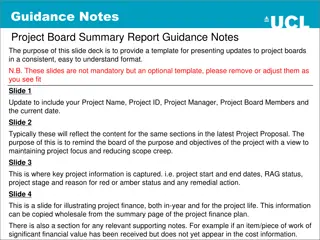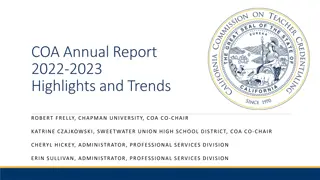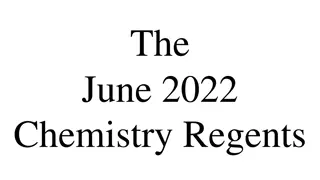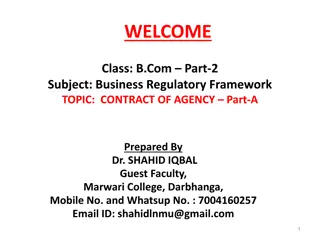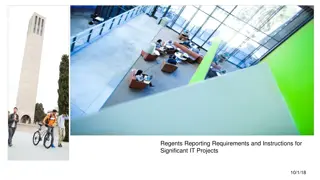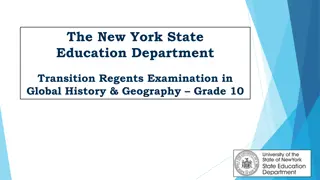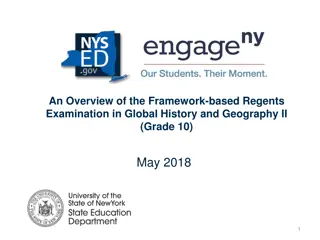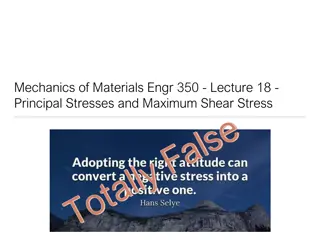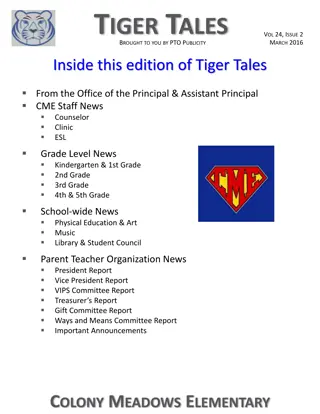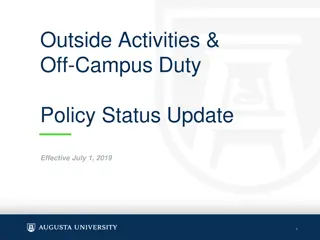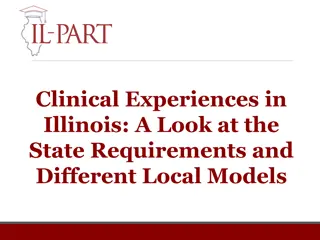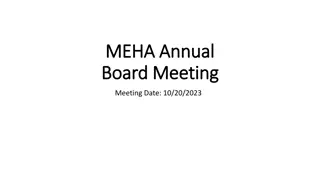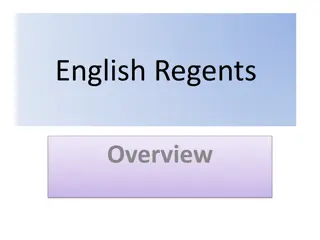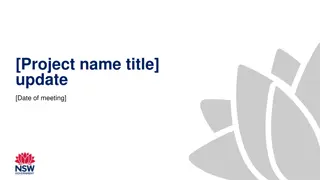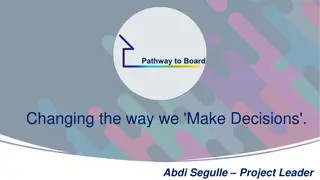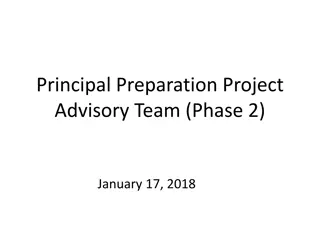Board of Regents Principal Preparation Project Update
Update presented to the Higher Education Committee of the Board of Regents on the progress of the Principal Preparation Project. The project focuses on improving school leadership through a grant accepted in December 2015. Activities include assembling an advisory team, holding meetings, developing a website, conducting a literature review, completing surveys, and identifying belief statements. Progress also includes drafting recommendations and involving urban districts as test-beds.
Uploaded on Sep 07, 2024 | 1 Views
Download Presentation

Please find below an Image/Link to download the presentation.
The content on the website is provided AS IS for your information and personal use only. It may not be sold, licensed, or shared on other websites without obtaining consent from the author.If you encounter any issues during the download, it is possible that the publisher has removed the file from their server.
You are allowed to download the files provided on this website for personal or commercial use, subject to the condition that they are used lawfully. All files are the property of their respective owners.
The content on the website is provided AS IS for your information and personal use only. It may not be sold, licensed, or shared on other websites without obtaining consent from the author.
E N D
Presentation Transcript
Principal Preparation Project Update Presented to the Higher Education Committee of the Board of Regents May 8, 2017
Recap: Deliverables ANTICIPATED OUTCOMES In December 2015, the Board of Regents accepted a grant to improve school building leadership (i.e., principal preparation) with the following areas of focus: Review requirements related to the preparation of school building leaders in New York State Identify if improvements are needed (related to certification and program standards, professional development, supervision, and/or evaluation) If warranted, forward recommendations to the Commissioner and Board of Regents for consideration and action Develop a tool to help districts identify, select, and place school building leaders (leader tracking tool) 2
What has Transpired Since Last Update to Regents on September 12th, 2016 PRESENTATION TO NYS BOARD OF REGENTS PROGRESS SINCE SEPTEMBER 12, 2016 Assembled a Project Advisory Team in September 2016 See Appendix A from the text version of the Board item Held 6 meetings of Principal Project Advisory Team (September 2016 May 2017) Developed web site to house documents http://www.nysed.gov/schools/prinicpal-project-advisory-team Completed a review of the literature on principal preparation http://www.nysed.gov/common/nysed/files/summary-of-the-literature-on-principal- preparation.pdf http://www.nysed.gov/common/nysed/files/summary-of-the-literature-on-principal- preparation-part-two.pdf http://www.nysed.gov/common/nysed/files/principal-project-summary-of-the-literature- on-principal-preparation-part-three.pdf 3
What has Transpired Since Last Update to Regents on September 12th, 2016 CONTINUED PROGRESS SINCE SEPTEMBER 12, 2016 Completed online survey from October-November 2016 (n=676) Note: Participants included P12 educators, deans and faculty at schools of education in institutions of higher education, and local school board members. See Appendix M. Results are at this link: http://www.nysed.gov/common/nysed/files/principal-project-graphs-from-the-surveys- conducted-oct-11-to-nov-2-2016-nov-8-2016.pdf Identified belief statements to guide the Advisory Team See Appendix E from the text version of the Board item. See Appendix F from text version of Board item for participant response to beliefs. Two urban districts agreed to serve as leader tracking tool test-beds School districts in Buffalo and Syracuse agreed to serve. Polled Regents on the Professional Standards for Educational Leaders Drafted preliminary recommendations See Appendix G from the text version of the Board item for draft possibilities. 4
What has Transpired Since Last Update to Regents on September 12th, 2016 MOST RECENT PROGRESS PROGRESS SINCE SEPTEMBER 12, 2016 Completed 22 integrated focus groups (from March 3 to April 10, 2017) Participants included parents, teachers, educators who hold School Building Leader certification (principals, assistant principals, etc.), Superintendents and District Superintendents, deans and faculty at schools of education in institutions of higher education, and local school board members (or Community Education Council members in the case of NYC). Schedule of dates and locations were sent to the NYS Board of Regents (see Appendix U). Focus group results are found at these links: http://www.nysed.gov/common/nysed/files/graphs-reaction-235-survey-respondents- to-recommendations-apr-11-2017.pdf See Appendix H from text version of Board item for reaction to recommendations. See Appendix I from text version of the Board item for focus group themes. Initiated studies of the alignment between School Building Leader certification exam and Professional Standards for Educational Leaders Polled Deans on Professional Standards for Educational Leaders (n=13) See Appendix J from text version of the Board item for a summary of dean responses.5
Recap: Deliverables STARTING POINT: VISION To develop a sense of possibility, Advisory Team members addressed a single question at the outset: If we could have what we want in an ideal program to prepare school building leaders, what would we have? 6
Recap: Deliverables THEMES CAPTURED IN BELIEF STATEMENTS Themes emerged from the responses provided by Team members. 7
Survey of the Field CONSENSUS BELIEF STATEMENTS (APPENDIX E) Agreement reached on seven beliefs. Two examples are listed: Equity: Well prepared school building leader candidates cultivate a climate of compassion and care for the well-being of every child in the school; candidates create a culture that strives to support the learning needs of every student in an environment where all students are valued, are respected, and experience success regardless of differences (e.g., age, gender, socio-economic status, religion, race, ethnicity, sexual orientation, disability, native language, national origin, and other characteristics). Value Diversity: Effective school building leader preparation programs recruit and produce aspiring leaders from varied backgrounds and historically-under-represented populations who are committed to the success of every student, who value different learning styles, who promote instructional practices that capitalize on a range of cultural traditions, and who strive to eliminate prejudice, stereotype, bias, and favoritism. 8
Survey of the Field CONSENSUS BELIEF STATEMENTS (APPENDIX E) Agreement on beliefs reached in five other areas. Purpose Instruction Shared Decision-Making and Shared Leadership Collaborative Partnership Continuous Improvement and Change Management 9
SUMMARY OF STAKEHOLDER FEEDBACK SURVEY ADMINISTERED MARCH 3 APRIL 10, 2017 (n=235) Concerning beliefs that have been ADOPTED BY CONSENSUS: Prompt: These are an important foundation for principal certification. 99% agreed or strongly agreed (or 233 of 235) 76% strongly agreed (or 179 of 235) Prompt: I support these in concept 99% agreed or strongly agreed (or 233 of 235) 72% strongly agreed (or 169 of 235) Survey participants included parents, teachers, educators who hold the School Building Leader certification (principals, assistant principals, etc.), Superintendents and District Superintendents, local school board members (or members of Community Education Councils in the case of NYC), and deans or their designees from schools of education at institutions of higher education. 10
Survey of the Field SURVEY OF THE FIELD (RESULTS) Question 11: To improve the quality of school leader development programs in NYS, what one change would make the greatest difference (n=431)? 30% Percentage of total responses that cited each theme 25% 20% 15% 10% 5% 0% Increase classroom experience requirement Improve P12/Higher Ed partnership Improve internship experience Improve program focus Frequency 22% 22% 12% 5% Display showing the percentage of responses to an open-ended question and the frequency of particular themes that were cited. These results are from an online survey administered Oct. 11 Nov. 2, 2016. While 676 individuals responded to the multiple choice portion of the survey, 431 responded to an open-ended question. They are summarized here. Included were parents, teachers, educators who hold School Building Leader certification (principals, assistant principals, etc.), Superintendents and District Superintendents, local school board members (or members of Community Education Councils in the case of NYC), and deans or their designees from Ed Schools. See Appendix M. 12
What has Transpired Since Last Update to Regents on September 12th, 2016 REVIEWED, ATTENTION TURNED TO 5 AREAS WITH BELIEFS IN HAND AND DATA P12-Higher Education Partnership Enhance the productivity and healthy inter-dependency of the P12-Higher Education relationship Authentic Experiences and Internship Expand and improve the opportunities (not just within an internship) for principal candidates to apply the knowledge/skill they have acquired under real conditions Standards Replace 2008 standards that currently form the basis of initial certification with some form of 2015 Professional Standards for Educational Leaders Note: At the Sept. 12, 2016 Board of Regents meeting, a cross-walk was distributed that compared the 2008 standards from the Interstate School Leaders Licensure Consortium to the 2015 Professional Standards for Educational Leaders. See Appendix D in text version of the May 8, 2017 Board item. 13
What has Transpired Since Last Update to Regents on September 12th, 2016 REVIEWED, ATTENTION TURNED TO 5 AREAS WITH BELIEFS IN HAND AND DATA Diversity Produce school building leaders from varied backgrounds (including historically under-represented populations) and prepare all school building leaders with the skills/knowledge to meet varied learning needs of a diverse student population. Professional Learning and Support Improve support beyond appointment as principal to foster situational awareness, system thinking, shared leadership, stakeholder engagement. Note: See Appendix B for organization chart that appears on next slide. 14
DRAFT RECOMMENDATIONS BEING CONSIDERED BY THE ADVISORY TEAM: NEXT STEPS Possible Recommendations: 1. Base initial principal certification on the most-current national standards for educational leaders. 2. Translate the 2015 Professional Standards for Educational Leaders into competencies that become basis for determining certification readiness. 3. Decide whether to eliminate, revise, or replace the current School Building Leader exam. Consider augmenting or replacing it with a competency-based assessment. 4. Make initial principal certification competency-based (i.e., aspiring leaders apply knowledge and skill in a school setting to improve staff functioning, student learning, or school performance). 5. Create pathways, options and/or opportunities leading to full-time, year- long, school-based internships for aspiring principals. 16
DRAFT RECOMMENDATIONS BEING CONSIDERED (CONTINUED): NEXT STEPS Possible Recommendations: 6. Ensure high-quality coaching and mentoring support extends through the first full year that a principal is on the job. 7. Adopt expectations that call for principals to acquire the knowledge and skill that prepares them to supervise instruction in ways that meet the learning needs of an increasingly-diverse student population. 8. Call for higher education institutions that offer School Building Leader programs to set goals, targets, and milestones for increasing the number and percent of candidates from historically-under-represented populations who enroll and complete the program. Call for districts to set goals to recruit, select, develop, and place individuals from historically under-represented populations within the ranks of school building leaders. 9. Set a schedule for phasing in implementation. 17
OVERVIEW OF LEADER TRACKING TOOL NEXT STEPS DEVELOPMENT Phases of the work: Concept definition Demonstration platform assembled Limited production within two urban districts (test-bed) Scaling beyond two districts Phased deployment 18
ACTIVITIES RELATED TO LEADER TRACKING TOOL DEVELOPMENT NEXT STEPS Sequence and milestones: 1. 2. 3. 4. 5. 6. 7. 8. 9. 10. Scale beyond two test-bed districts 11. Phase-in deployment (Jan, 2018 and beyond) Completed Scope of Work for Request for Bid Enlisted two urban districts as development test-beds (Buffalo and Syracuse) Identified qualified vendor(s) Disseminated request for bid to the field Receive and review bids (in progress) Award bid for work Complete concept definition Complete demonstration platform Complete limited production in test-bed districts 19
GRANT FUNDING EXTENSION APPROVED BY THE REGENTS IN DECEMBER 2016 NEXT STEPS On December 13, 2016 the Board of Regents approved a $500,000 grant from Wallace Foundation to extend this work Better define relationship between university-based preparation programs and districts that host internships for aspiring principals Study whether/how to apply Title II Part A funds for this effort Create a case study of the NYS approach to ESSA planning Note: This particular aspect of the project is designed to identify and bundle lessons learned in NYS during the course of ESSA planning and make them accessible to a wide audience of state policymakers in the United States. Telling the NYS story helps document how a state education department relied on stakeholders to surface key insights that led in turn to proposed changes in educational processes in ways that expand equity in opportunities and outcomes for young people. Study merit of adding competency-based tasks to certification Provide support for proposition that aspiring principals apply what they know in authentic settings prior to certification 20
NEXT STEPS May 1, 2017 Identify consensus recommendations (invite feedback) May 31, 2017 Reach consensus on final adjustments June 1, 2017 Forward recommendations for consideration 21



